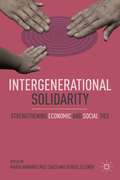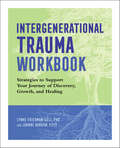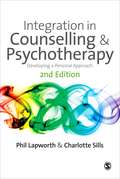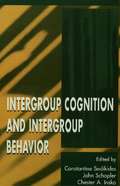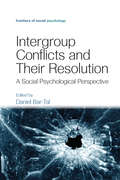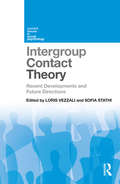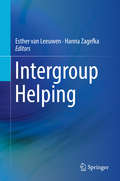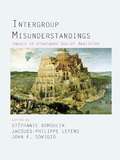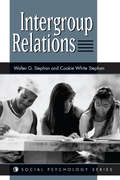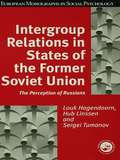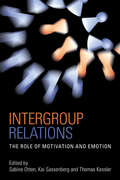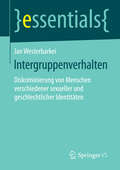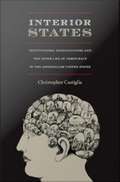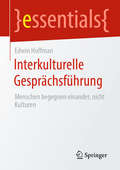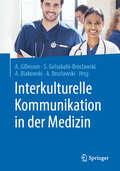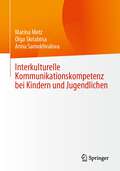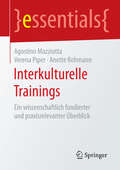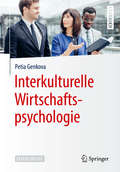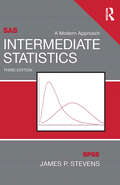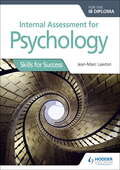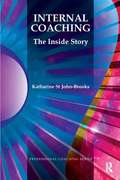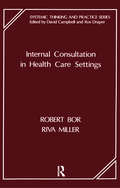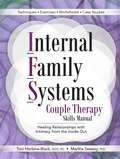- Table View
- List View
Intergenerational Solidarity
by María Amparo Cruz-Saco Sergei ZelenevThis volume analyzes intergenerational solidarity from diverse interdisciplinary angles within the social sciences. It provides analytical tools to advance research and documents how societies are adjusting to major changes that affect the core of the social fabric.
Intergenerational Trauma Workbook: Strategies to Support Your Journey of Discovery, Growth, and Healing
by Lynne Friedman-Gell Joanne BarronTools, exploration, and actions to help you heal from intergenerational traumaStart on the path to healing from trauma that has been passed down through your family. The Intergenerational Trauma Workbook helps you understand the ways in which trauma can move from generation to generation while also providing practical, straightforward exercises to help you grow and heal.Drawing on their combined decades of experience treating trauma, Dr. Lynne Friedman-Gell and Dr. Joanne Barron have created an accessible and compassionate workbook that teaches you how to recognize and identify the effects that intergenerational trauma is having on your life. You'll discover a variety of easy-to-use, evidence-based strategies that will not only help you heal but also help break the cycle of your family's trauma.The Intergenerational Trauma Workbook features:Intergenerational focus—Get advice specifically tailored to deal with the unique challenges and consequences of family trauma passed down through generations.Proven techniques—Manage difficult thoughts and emotions, and heal your body and relationships, with techniques developed across years of clinical experience and practice.Supportive anecdotes—Realize you aren't alone, and draw strength from the stories of other people's healing journey from intergenerational trauma.Begin the process of healing today with the Intergenerational Trauma Workbook.
Intergration in counselling & psychotheraphy: Developing a Personal Approach
by Phil Lapworth Charlotte SillsNow in its Second Edition, this book is established reading for any practitioner or trainee wishing to develop their own personal style of working. As well as examining contemporary integrative approaches, the authors show how to develop an individual approach to integrating theories and methods from a range of psychotherapies. Offering clear strategies for integration rather than a new therapeutic model, this practical new edition puts added emphasis on the integrative framework, and procedural strategies, extending discussion of the individual practitioner as integrator.
Intergroup Cognition and Intergroup Behavior (Applied Social Research Series)
by Constantine Sedikides John Schopler Chester A. InskoSocial psychology has maintained a keen interest over the years in issues related to intergroup behavior, such as ingroup favoritism and discrimination. The field has also been preoccupied with ways to reduce prejudice and discrimination. Intergroup contact has been offered as the main mechanism for prejudice and discrimination reduction. In the last 15 years, the social cognitive perspective has been applied to the study of intergroup relations. Theoretical advances have been made regarding such issues as the representation of information about ingroup and outgroup members, the structural properties of stereotypes, the relation between cognitive representation and judgment, and the ways in which cognition, effect, and motivation interactively influence the perception, judgment, and memory of ingroup and outgroup members. The first volume in this new series, this book seeks to bring the above two traditions together. Focusing on the interplay between cognition and behavior in intergroup settings, it addresses four general questions: * How does intergroup cognition (perceptions, judgments, and memories) influence intergroup behavior (ingroup favoritism and discrimination)? * How does intergroup behavior subsequently change intergroup cognition? * What is the mediational role of effect, motivational processes, and social context? * How effective can change in intergroup cognition be in altering intergroup behavior? This volume focuses not on a specific theory but rather on an approach. This approach is the interface between intergroup cognition and intergroup behavior. The various contributors are leading investigators in these areas and share the belief that the field has reached a level of maturity where it can start asking the hard questions regarding the complex and multifaceted ways in which intergroup cognition and behavior are related. The investigators do not just summarize their work. Instead, they connect aspects of their work to the theme of the volume and integrate their work with existing approaches in the relevant literature.
Intergroup Conflicts and Their Resolution: A Social Psychological Perspective (Frontiers of Social Psychology)
by Daniel Bar-TalThis book provides a framework that sheds an illuminating light into the psyche of people involved in macro-level destructive intergroup conflicts, involving societies and ethnic groups, that take place continuously in various parts of the globe. It focuses on the socio-psychological repertoire that evolves in these societies or groups and which plays a determinative role in its dynamics. Specifically, this repertoire influences the nature of social reality about the conflict that society members construct, the involvement with and mobilization of society members for the conflict, the sense of solidarity and unity they experience, the conformity expected from society members, the pressure exerted on leaders, and the direction of action taken by the leadership. In addition, the book describes the changes in the socio-psychological repertoire that are necessary to ignite the peace process. Finally, it elaborates on the nature and the processes of peace building, including conflict resolution and reconciliation. The proposed conception assumes that although each conflict has its unique context and characteristics, the socio-psychological foundations and dynamics are similar. It offers a holistic and comprehensive outlook on the dynamics that characterize each stage and aspect of intractable conflicts. Each chapter systematically elucidates a particular part of the cycle, describing the theoretical frameworks and concepts, as well as presenting empirical data that was accumulated. The volume is an important contribution for all those who study intergroup conflicts and want to understand their dynamics. In addition, the book will interest the many people attempting to settle conflicts peacefully and who need knowledge about the socio-psychological vectors that influence their course and resolution.
Intergroup Contact Theory: Recent developments and future directions
by Loris Vezzali Sofia StathiIntergroup contact theory has been one of the most influential theories in social psychology since it was first formulated by Gordon Allport in 1954. This volume highlights, via a critical lens, the most notable recent developments in the field, demonstrating its vitality and its capacity for reinvention and integration with a variety of seemingly distinct research areas. In the last two decades, the research focus has been on the variables that explain why contact improves intergroup attitudes and when the contact-prejudice relationship is stronger. Current research highlights that contact is not a panacea for prejudice, but it can represent a useful tool that can contribute to the improvement of intergroup relations. The book includes coverage of a number of previously under-researched fields, which extend the full potential of contact theory within the personality, acculturation and developmental domains. The chapters also examine the methodological advances in the field and the applied implications. The book offers a rich picture of the state of the field and future directions for research that will be invaluable to students and scholars working in social psychology and related disciplines. It aims to provide fertile ground for the development of new, exciting and dynamic research ideas in intergroup relations.
Intergroup Helping
by Esther Van Leeuwen Hanna ZagefkaThe aim of this volume is to provide an overview of research from different psychological domains with regards to intergroup helping, arguing for intergroup helping as a research area in and of itself. Historically, research on intergroup relations has largely overlooked helping between groups--which, combined with the fact that most of the research on altruism and helping has focused on individuals, meant that intergroup helping was primarily looked at as deriving from negative intergroup interactions, such as ingroup bias or discrimination. However, over the last decade, a small but growing group of researchers started to investigate intergroup helping as a positive social act occurring between and amongst groups. With contributions from these expert researchers, this volume makes the case that intergroup helping should be studied as a phenomenon in and of itself, not as a mere expression of negative intergroup behaviour. To advance this argument, the first section covers traditional research approaches in which the willingness to help other groups is construed as a form of discrimination. Then, the second section looks at the reasons why people may be motivated to help other groups. Finally, the last section explores intergroup helping in real world settings, looking at natural disaster responses and the role of morality, among other topics, demonstrating that intergroup relations can be truly positive. Thus, Intergroup Helping: The Positive Side of Intergroup Behavior informs researchers in positive and group relations psychology about the current state of affairs of research on intergroup cooperation and helping, and sets out an agenda for further exploration. Tapping into a current trend towards positive psychology, it moves away from the traditional view within intergroup relations research of the group as a 'source of trouble', and instead focuses on truly positive intergroup relations, with the ultimate goal of promoting real positive behaviour that breaches the intergroup divide.
Intergroup Misunderstandings: Impact of Divergent Social Realities
by John F. Dovidio Jacques-Philippe Leyens Stéphanie DemoulinThe objectives of the volume are to direct the field’s attention to the unique value of studying interactions between members of different groups and to offer the most up-to-date summaries of prominent and cutting-edge scholarship on this topic written by leading scholars in the field. A central theme of the volume is that improvement in intergroup relationships will only be possible if social scientists simultaneously take into account both the attitudes, beliefs, emotions, and actions of the different groups that shape the nature of intergroup relations. Understanding how members of different groups interact is critical beyond the value of understanding how majority groups behave and how minority groups respond in isolation. Indeed, as the book exemplifies, groups interpret their interaction differently, experiencing different social realities; approach interactions with different goals; and engage each other with different, and often non-compatible, means or strategies. These different realities, goals, and strategies can produce misunderstanding, suspicion, and conflict even when initial intentions are positive and cooperative. The book will be of interest to professionals and students in social psychology, sociology, social work, education, political science, and conflict management, as well as scholars, students, and practitioners interested in anti-bias education and prejudice reduction techniques and strategies.
Intergroup Relations (Social Psychology Series)
by Cookie W StephanExplores the stereotypes, prejudices, and discriminatory behavior of individuals and the manner in which these cognitions, feelings, and behaviors both affect others and are affected by others. Stephan and Stephan suggest measures to help overcome bias and improve intergroup relations that utilize techniques for eliminating stereotypes, reducing prejudice, and resolving conflicts in real-world situations. Designed to enrich all of our lives by combatting preconceptions, this book makes a significant contribution to our understanding of ourselves and others.The authors look at school desegregation in the United States as an extended case study. Throughout the book, they address social identity theory; culture shock and ethnocentrism; the effectiveness of deterrence, negotiation, mediation, and unilateral de-escalation; as well as the contact hypothesis. This social psychological analysis of intergroup relations is appropriate for undergraduates and graduates in social psychology, sociology, communications, and counseling.
Intergroup Relations in States of the Former Soviet Union: The Perception of Russians (European Monographs in Social Psychology)
by Louk Hagendoorn Hub Linssen Sergei TumanovThe disintegration of the Soviet Union in 1991 left 25 million Russians living outside the Russian Federation. This important new book explores their social identity, examining the mutually held perceptions, fears and resulting nationalism of both the ethnic Russians living outside the Russian Federation and the indigenous, or 'titular', populations they live amongst. Based on a unique study involving national surveys conducted in Belarus, Ukraine, Moldova, Georgia and Kazakhstan, the book maps the main individual, intergroup and cross-national factors that shape the fears of 'titulars' and Russians as well as the possible consequences and the risk of ethnic conflict in the five republics. There is detailed statistical analysis of how background factors (personal and national) affect intergroup perceptions; along with discussion of mutual stereotypes, social distance, language and the perception of citizenship and analysis of the dynamics of assimilation and separation of Russians in former soviet states. The attitudes of both groups to other smaller minority groups are also examined.This book provides significant new conclusions on the complexity of intergroup relations and seeks to relate these findings to a general theory of intergroup relations. It will be essential reading for those working in this area within the disciplines of Psychology, Sociology and Politics.
Intergroup Relations: The Role of Motivation and Emotion (A Festschrift for Amélie Mummendey) (Psychology Press Festschrift Series)
by Kai Sassenberg Thomas Kessler Sabine OttenThis volume gives a survey of the most recent developments and trends in intergroup research. Diverging from classical approaches that looked at diverse needs and motives (positive distinctiveness, belongingness, etc), the present book focuses not only on the question what motivates intergroup behaviour, but especially on how the motivation of intergroup behaviour functions. The book focuses on the role of emotion and motivation in the development of intergroup conflict, social exclusion, tolerance and other group related phenomena. The sections demonstrate how classical theories in the field have been further developed, enriched, and more sophisticatedly tested over the years, and summarise research on affect and memory. They also develop a group based self-regulation approach, examine several specific emotions as motivational forces of intergroup behaviour, and look at factors of intergroup relations that lead to social change. The chapters are short and easy-to-comprehend summaries referring to a broad range of original work, providing a useful resource for advanced students of Social Psychology and researchers in the field of intergroup relations.
Intergruppenverhalten: Diskriminierung von Menschen verschiedener sexueller und geschlechtlicher Identitäten (essentials)
by Jan WesterbarkeiDie Bildungsplanreform 2015 in Baden-Württemberg hat eine neue Debatte über die gesellschaftliche Akzeptanz sexueller Vielfalt ausgelöst. Die Landesregierung plant, fächerübergreifend die Pluralität sexueller Lebensformen im Schulunterricht zu thematisieren, um Akzeptanz gegenüber Menschen verschiedener sexueller und geschlechtlicher Identitäten zu fördern. Allerdings hat sich in einer Petition im Internet eine Protestbewegung formiert, die gegen eine vermeintliche ideologisch geprägte Umerziehung ihrer Kinder aufbegehrt. Aufgrund der hohenZahl von Unterzeichnern konnte die Petition großes mediales und politisches Aufsehen erregen. Jan Westerbarkei wertet in diesem Band die Kommentare der Unterstützer der Petition anhand von Theorien zu Intergruppenverhalten aus. DieBildung vorurteilsbehafteter Aussagen durch wahrgenommene Bedrohungen inGruppenkonflikten stellt dabei den Kern der Analyse dar.
Interior States: Institutional Consciousness and the Inner Life of Democracy in the Antebellum United States
by Christopher CastigliaIn Interior States Christopher Castiglia focuses on U. S. citizens' democratic impulse: their ability to work with others to imagine genuinely democratic publics while taking divergent views into account. Castiglia contends that citizens of the early United States were encouraged to locate this social impulse not in associations with others but in the turbulent and conflicted interiors of their own bodies. He describes how the human interior--with its battles between appetite and restraint, desire and deferral--became a displacement of the divided sociality of nineteenth-century America's public sphere and contributed to the vanishing of that sphere in the twentieth century and the twenty-first. Drawing insightful connections between political structures, social relations, and cultural forms, he explains that as the interior came to reflect the ideological conflicts of the social world, citizens were encouraged to (mis)understand vigilant self-scrutiny and self-management as effective democratic action. In the late eighteenth century and early nineteenth, as discourses of interiority gained prominence, so did powerful counter-narratives. Castiglia reveals the flamboyant pages of antebellum popular fiction to be an archive of unruly democratic aspirations. Through close readings of works by Maria Monk and George Lippard, Walt Whitman and Timothy Shay Arthur, Hannah Webster Foster and Hannah Crafts, and Nathaniel Hawthorne and Herman Melville, Castiglia highlights a refusal to be reformed or self-contained. In antebellum authors' representations of nervousness, desire, appetite, fantasy, and imagination, he finds democratic strivings that refused to disappear. Taking inspiration from those writers and turning to the present, Castiglia advocates a humanism-without-humans that, denied the adjudicative power of interiority, promises to release democracy from its inner life and to return it to the public sphere where U. S. citizens may yet create unprecedented possibilities for social action.
Interkulturelle Gesprächsführung: Menschen begegnen einander, nicht Kulturen (essentials)
by Edwin HoffmanWir alle kommen mit der Superdiversität der Gesellschaft in Kontakt, die zeigt, wie geschichtet, kontextabhängig und veränderlich sich Menschen sozial organisieren und identifizieren. Kulturelle Identität ist schon lange nicht mehr nur mit der nationalen Herkunft identisch, Autochthone und Migranten aus zahlreichen Herkunftsländern haben jeweils ihre eigene Vielfalt an Bevölkerungsgruppen und sozialen Kategorien. Was bedeutet diese Superdiversität für die professionelle Kommunikation? Edwin Hoffman bietet in diesem essential mit vielen Beispielen einen innovativen Ansatz, der auf zwischenmenschlicher Kommunikation und nicht auf der Begegnung von Kulturen basiert. Das TOPOI-Modell enthält Handlungsstrategien zur Reflexion und Überbrückung von Kommunikationsunterschieden.
Interkulturelle Kommunikation in der Medizin
by Anton Gillessen Solmaz Golsabahi-Broclawski André Biakowski Artur BroclawskiDas Buch zeigt aus multiperspektivischer Sicht, wie elementar die interkulturelle Kommunikation auf Augenhöhe für ein vertrauensvolles Arzt-Patienten-Verhältnis im Praxis- und Klinikalltag ist. Ein Buch für Ärzte und Psychologen, das darüber hinaus alle Berufsgruppen in der Sozial- und Integrationsarbeit anspricht.Ausgehend von den aktuellen Erkenntnissen der internationalen Migrationsforschung werden dem Leser Wertevorstellungen und Verhaltensschemata in der Kommunikation zwischen Ärzten, Integrationshelfern und Menschen mit Zuwanderungshintergrund aufgezeigt. Im Fokus stehen dabei kultur-, sozial- und religionsanthropologischen Aspekte, die für die Integration von Flüchtlingen, Migranten und Spätaussiedlern im Kontext des Gesundheitswesens relevant sind. Anhand von Fallbeispielen bietet das Buch für verschiedene medizinische Fachgebiete praktische Handlungsempfehlungen für eine kultursensible und gleichberechtigte Arzt-Patienten-Beziehung.
Interkulturelle Kommunikationskompetenz bei Kindern und Jugendlichen
by Marina Metz Olga Skriabina Anna SamokhvalovaDas Buch ist für Fachkräfte geeignet, die mit Kindern und Jugendlichen im interkulturellen Kontext arbeiten, Psychologinnen, Pädagoginnen, Erzieherinnen und Lehrerinnen. Das Wissen über die verschiedenen Vermittlungsmöglichkeiten von interkulturellen Inhalten ermöglicht eine bessere Wahl der Kommunikationsformen, um die Kommunikation effektiver, zielgerichteter und respektvoller zu gestalten. Das Buch greift wichtige theoretische Erkenntnisse zur Interkulturellen Kommunikationskompetenz auf, erklärt diese auf eine veranschauliche Weise und gibt zahlreiche forschungs- und praxisrelevante Beispiele.
Interkulturelle Trainings: Ein wissenschaftlich fundierter und praxisrelevanter Überblick (essentials)
by Agostino Mazziotta Verena Piper Anette RohmannDieAutorInnen bieten einen wissenschaftlich fundierten und gleichzeitigpraxisnahen Überblick über interkulturelle Trainings. Herausforderungen imRahmen der Planung und Durchführung werden abgebildet und es wird aufgezeigt,wie deren Wirksamkeit in der Praxis erhöht werden kann. Als Anregung zurkritischen Auseinandersetzung mit den Inhalten sind gezielte Fragen zurReflexion sowie eine Checkliste für die Bewertung von bereits entwickeltenTrainingsmaßnahmen enthalten. Zusätzlich schildern die AutorInnen Beispieletheoretisch fundierter Trainings und geben Hinweise für eine gelungene Konzeptioneigener Maßnahmen.
Interkulturelle Wirtschaftspsychologie (Springer-Lehrbuch)
by Petia GenkovaDieses Lehrbuch befasst sich mit den kulturellen Unterschieden in der Wirtschaftspsychologie. Im Mittelpunkt steht die Wechselwirkung zwischen Kultur und ihrem Einfluss auf Denken und Verhalten im wirtschaftlichen Kontext. Mit Lernzielen, Praxistipps, Definitionen, Verständnisfragen und Zusammenfassungen ist dieses Werk didaktisch klar strukturiert und leicht verständlich aufgebaut. Eindrücklich zeigt es auf, welche Phänomene eher universell, d.h. in allen Kulturen gültig sind, und welche der affektiven, kognitiven und verhaltensbezogenen Phänomene eher kulturspezifischen Regeln und Normen unterliegen. Zum besseren Verständnis sind die Zusammenhänge praxisnah mit Fallbeispielen veranschaulicht. Aktuelle Studien runden die wissenschaftlichen Grundlagen mit interessanten Erkenntnissen und Beispielen ab. Direkte Handlungsimplikationen regen zum Nachdenken an und laden zur praktischen Umsetzung ein.
Intermediate Statistics: A Modern Approach, Third Edition
by James P. Stevens Keenan A. Pituch Tiffany A. WhittakerJames Stevens' best-selling text, Intermediate Statistics, is written for those who use, rather than develop, statistical techniques. Dr. Stevens focuses on a conceptual understanding of the material rather than on proving the results. SAS and SPSS are an integral part of each chapter. Definitional formulas are used on small data sets to provide conceptual insight into what is being measured. The assumptions underlying each analysis are emphasized and the reader is shown how to test the critical assumptions using SPSS or SAS. Printouts with annotations from SAS or SPSS show how to process the data for each analysis. The annotations highlight what the numbers mean and how to interpret the results. Numerical, conceptual, and computer exercises enhance understanding. Answers are provided for half of the exercises. The book offers comprehensive coverage of one-way, power, and factorial analysis of variance, repeated measures analysis, simple and multiple regression, analysis of covariance, and HLM. Power analysis is an integral part of the book. A computer example of real data integrates many of the concepts. Highlights of the Third Edition include: A new chapter on hierarchical linear modeling using HLM6 A CD containing all of the book's data sets New coverage of how to cross validate multiple regression results with SPSS and a new section on model selection (Chapter 6) More exercises in each chapter. Intended for intermediate statistics or statistics II courses taught in departments of psychology, education, business, and other social and behavioral sciences, a prerequisite of introductory statistics is required. An Instructor's Resource is available upon adoption. See www.researchmethodsarena.com .
Intermediate World History В (Student Pages, Semesters 1 & #2)
by K12A textbook on world history from K12 Inc.
Internal Assessment for Psychology for the IB Diploma: Skills Success Epub
by Jean-Marc LawtonSupport progress through the Internal Assessment, walking students through criteria, how to choose a topic, approach experimentation and analyse and evaluate results for the final report. · Build skills through a range of strategies and detailed examiner advice and expert tips. · Ensure understanding of all IB requirements with clear, concise explanations on the assessment objectives and rules on academic honesty, as well as explicit reference to the IB Learner Profile and ATLS throughout. · Encourage students to achieve the best grade with advice and tips, including common mistakes to avoid, exemplars, worked answers and commentary, helping students to see the application of facts, principles and concepts. · Reinforce comprehension of the skills with activity questions. · Support visual learners with infographics at the start of every chapter.
Internal Assessment for Psychology for the IB Diploma: Skills for Success
by Jean-Marc LawtonSupport progress through the Internal Assessment, walking students through criteria, how to choose a topic, approach experimentation and analyse and evaluate results for the final report. · Build skills through a range of strategies and detailed examiner advice and expert tips. · Ensure understanding of all IB requirements with clear, concise explanations on the assessment objectives and rules on academic honesty, as well as explicit reference to the IB Learner Profile and ATLS throughout. · Encourage students to achieve the best grade with advice and tips, including common mistakes to avoid, exemplars, worked answers and commentary, helping students to see the application of facts, principles and concepts. · Reinforce comprehension of the skills with activity questions. · Support visual learners with infographics at the start of every chapter.
Internal Coaching: The Inside Story (The\professional Coaching Ser.)
by Katharine St John-BrooksInternal Coaching: The Inside Story provides a window into the world of internal coaching: the challenges and rewards for the coaches themselves and the ways in which organisations can ensure that they can get best value for money from their investment in them.Internal coaching is booming. A recent survey showed that nearly four fifths of large organisations in the UK believe that internal coaching (that is coaching delivered by one employee to another in a different chain of command) will grow over the next three years. Yet there has been surprisingly little written about the unique nature of the internal coaching role. Drawing on the stories of hundreds of internal coaches, coach sponsors, lead coaches, supervisors of internal coaches and coach trainers, Internal Coaching: The Inside Story gives internal coaches a voice. It makes available to hard-pressed HR directors, talent managers, and learning and development professionals the fruits of very practical research into what is working in organisations and how they might maximise the value for money they get from their investment in internal coaches.
Internal Consultation in Health Care Settings (The Systemic Thinking and Practice Series)
by Robert Bor Riva MillerRobert Bor and, Riva Miller, who run the AIDS Counseling Service at the Royal Free Hospital, London, are internationally known for their work in providing consultation to many hospital departments from within the hospital itself. Internal Consultation in Health Care Settings should, however, be of interest to anyone working within a large organization. The authors have produced a step-by-step guide to negotiating an internal consultation; and, in a very comprehensive manner, they have described their theoretical framework and the consultation work itself, both based on their own application of systemic thinking. The book is illustrated throughout with examples drawn from their own work.
Internal Family Systems Couple Therapy Skills Manual: Healing Relationships with Intimacy From the Inside Out
by Toni Herbine-Blank Martha SweezyYou can help even the most conflicted, disconnected couples restore and heal their relationship. IFS Couple Therapy Skills Manual presents clinicians with a powerful, non-pathologizing approach to helping couples better understand themselves, their differences, and the underlying reasons for their suffering. Working from the lens of Intimacy from the Inside Out (IFIO) – a branch of Internal Family Systems (IFS) therapy – the authors provide a highly successful therapy that allows couples to feel understood, to decrease shame, and to reestablish loving connections. Inside you’ll find: - Step-by-step techniques - Case examples - Experiential exercises - Clear treatment explanations - Downloadable worksheets
